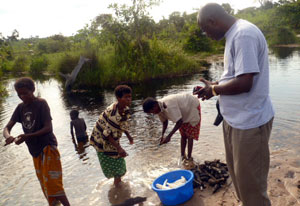Cassava root causes cognitive damage in Congolese villages
January / February 2014 | Volume 13, Issue 1

Photo courtesy of Dr. Desire Tshala-Katumbay,
Oregon Health and Science University
Eating unprocessed cassava can damage the brain,
researchers found.
By Cathy Kristiansen
In impoverished regions of sub-Saharan Africa, some villagers need sticks to walk because of neurological damage from the very food that keeps them from starvation - cassava. Toxins in the tuber can cause sudden and irreversible paralysis and, researchers have learned, also undermine cognitive ability even without overt physical symptoms.
This problem has widespread public health implications because cassava, also known as yucca, manioc and tapioca, is a dietary staple for more than 600 million people globally. The cyanide it contains as a chemical defense against herbivores and insects is normally removed by processing through soaking, peeling and drying, but in stressed conditions such as drought, famine and armed conflict, people may eat cassava only partially processed and risk neurological damage.
One country with the highest prevalence of this paralysis is the Democratic Republic of Congo, where the condition is known as konzo and can affect up to 5 percent of people in some villages. A research team decided to investigate the extent of neurological damage from cassava as a first step toward finding interventions to reduce it. Congolese-born U.S. researcher Dr. Desire Tshala-Katumbay of both Oregon Health and Science University and the University of Kinshasa and Dr. Michael Boivin of Michigan State University obtained support from Fogarty's brain disorders program, with additional funding from the NIH's National Institute of Environmental Health Sciences (NIEHS). With Dr. Jean-Jacques Meyembe of the Congo National Institute of Biomedical Research, they conducted a study in the Kahemba district.
The team enrolled preteens from villages with and without konzo and gave them standard cognitive and motor proficiency tests. All children in konzo-harboring villages - even without physical symptoms - showed poorer memory than children from konzo-free villages. Those in konzo villages additionally lagged in visual-spatial aptitude and in mental processing. These results suggest that even without physical manifestations from cassava toxins, some children suffer damage and the overall burden of cassava-related brain impact may have been underestimated. The team is also working on a biomarker to predict deficits in konzo patients and is investigating whether genetic susceptibility or dietary patterns can explain the spate of cases within families.

Photo courtesy of Dr. Desire Tshala-Katumbay,
Oregon Health and Science University
Fogarty-supported researcher Dr. Desire Tshala-
Katumbay observes Congolese women soaking
cassava to remove toxins that could trigger
paralysis and undermine cognition.
Tshala-Katumbay said he hopes multidisciplinary teams will develop remedies, such as projects to educate villagers about adequate cassava processing methods, to reduce related brain injury. Additional lines of research include the role of gut flora in modulating risks tied to eating improperly processed cassava and the impact of comorbidities such as infections.
"There is more attention to the problem and more research is being done," he continued. He noted Dr. Banea Mayumbu, head of the Congo government's nutrition program, and Dr. Dieudonne Mumba at the University of Kinshasa have joined the research team to provide multidisciplinary expertise. "I hope in time we will get enough expertise to help the government focus on the problem and think about interventions to protect children from brain damage related to malnutrition and cassava toxicity," he concluded.
Fogarty's
Brain Disorders in the Developing World: Research across the Lifespan program is designed to increase research capacity in low-resource countries and help improve neurological health for millions around the globe.
More Information
To view Adobe PDF files,
download current, free accessible plug-ins from Adobe's website.